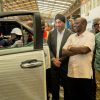
Kenya is ready for a ban on the importation of used vehicles because local assemblers have sufficient capacity to satisfy market demands, Associated Vehicle Assemblers (AVA) told AutoNews Magazine in an interview.
Moses Abiero, the AVA Head of Operations notes that the vehicle assembler is operating below its capacity. Abiero cited the high number of used imported units as a factor stifling demand for new and locally assembled vehicles. “Kenya has a liberalized vehicle market which tilts demand in favour of used imported units,” he explained. Abiero opines assemblers have enough capacity to meet local demand for vehicles.
The latest data from the Kenya National Bureau of Statistics (KNBS) shows that 78,304 units were imported into the country by September 2021. This represents an increase of 21% from 64,551 imported in a similar period in 2020. Vehicles from Japan account for about 80% of Kenya’s vehicle market share.
Some of the most popular models include Toyota, Nissan, Mazda and Subaru. “This makes it difficult for investors in the local vehicle assembly to fully optimize their operations. Some of the imported units are overpriced. Kenyans can get better deals with locally assembled vehicles,” explained Abiero adding that reliance on imported vehicles impedes the growth of Kenya’s manufacturing sector.
AVA, for example, employs over 300 people. The company is the biggest vehicle assembler in East and Central Africa and offers a wide range of motor engineering solutions including parts manufacturing and vehicle bodybuilding.
But the future of new vehicles looks bright. The government through the Ministry of Industrialization, Trade and Enterprise is implementing the Kenya Automotive Policy which will see a gradual reduction of used imported vehicles starting this year.
“The government has embarked on a move that will spur local vehicle assembly and manufacturing. It is a boost to the manufacturing sector and the economy of Kenya,” Abiero explained. Already, local vehicle assemblers are reaping from industry favourable government policies that aim to increase local demand for new vehicles.
In 2019 for example, the government banned the importation of used trucks exceeding loading capacities of 3.5 tonnes. However, an exemption was extended to bus importers.
This ban was premised on findings of a survey that revealed assemblers in Kenya have adequate capacity to produce this category of vehicles commonly used in construction work. “Such policies have not only created jobs but also significantly contributed to the growth of our industries.
This will also help the country close the gap on export-import imbalances,” Abiero added. In addition to this policy, the government has also shown increased commitment to buy or lease locally assembled vehicles.
In January 2022, Simba Corporation delivered 100 Mahindra Scorpio Cab pickups to the National Police Service. Simba Corporation owns AVA.

In the past year, new vehicle dealers in Kenya sold 14,250 units, a jump of 29.8% in growth from the 10,977 sold in 2020. This growth was driven by economic recovery from COVID-19. But government support to local vehicle assemblers goes beyond buying or leasing deals. In 2020, the government allocated Sh600 million to an economic stimulus programme in a bid to cushion assemblers from the effects of the COVID-19 pandemic.
While AVA appreciates government support to the local vehicle assemblers, Abiero believes full implementation of the Kenya Automotive Policy may be the magic elixir that will propel the assemblers to economic success.
“Before the vehicle market was liberalized in the 1990s, local assemblers were doing well. There are many benefits to buying new vehicles,” he said. Abiero disclosed that AVA plans to venture into the regional market by establishing an assembly plant in Tanzania. The move is expected to cement AVA’s position as a regional giant in vehicle assembly.
The company hopes to leverage the stipulates of the East African Community (EAC) Common External Tariff that prescribes duty-free access to locally CKD vehicles. Noting the government incentives are key catalysts for growth in vehicle assembly, Abiero adds trade barriers in the EAC have slowed business growth.
“We have good policies as a region but I think EAC member states need to harmonize trade tariffs for us to reach full potential. Cross border business has challenges,” he added.






